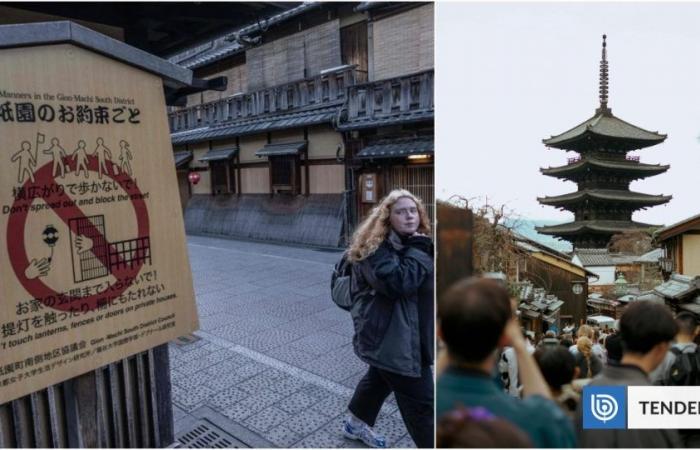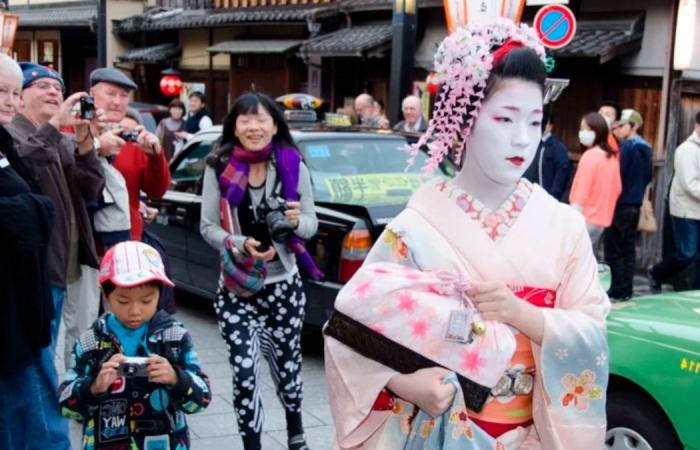Between 2023 and 2024, Japan has received 25 million touristsaccording to figures from the National Tourism Organization of the Asian country, which means a real success on an economic level that, even so, has not allowed the Japanese government to take a happy account, as it is studying various actions to combat the annoyance and social discomfort caused by the attitudes of visitors.
In this way, the Japanese authorities have implemented some measures such as the rise in prices in the most visited areas, taxes exclusively for tourists and even the prohibition of entering certain neighborhoods. A declaration of ‘war’ against mass tourism that seeks to balance economic benefits with the well-being of locals.
Japan’s early boredom with tourism
According to the latest data published by the United Nations (UN), 2.7% of the population in Japan are foreigners, that is, more than three million immigrants. Considering that the total number of inhabitants exceeds 125 million In the Asian country, foreigners do not have an influence on the interculturality of a Japanese society that only opened its doors to tourism in a transversal way in 2008.
With the need to boost the economy in other areas after the complex crisis at the end of the 90’s, in 2003, work began to promote tourism for the first time in cities such as Tokyo, Kyoto and Osaka. Three years later, the Japanese government approved a law that allowed this activity to be promoted and help small and medium-sized companies that were committed to this industry. However, Only in 2008 was an exclusive tourism entity created.
Following the relaxation of visa restrictions, Japan’s tourism boom has undergone a radical change over the past decade with the arrival of Chinese visitors. This country unleashed a frenzy of activity that some took full advantage of, while others fervently rejected, perceiving his neighbors as noisy and disorderly individuals, whose only notable attribute was their abundance of money. Despite this, it paved the way for Japan to present itself to the world as a dream destination.
As the ‘millennials’ -generation of people born between 1982 and 1994- were growing up and becoming professionals with more capital, with the attractive offer of visiting a culture that allowed the existence of different animes and video games, this problem became even more widespread in recent years. It was no longer just Chinese travelers who filled the streets of Tokyo or Kyoto, multiplying its own population by 30but that the era of ‘influencers’ and amateur photographers was here to stay in Japan, which, little by little, began to offer a better quality-price ratio, due to economic stagnation.
Speaking to the Guardian, Hiroshi, a worker at a popular hotel in Yokohama, emphasised how the falling yen and rising prices in other countries have allowed Japan to be such a pocket-friendly destination: “Before, coming here was prohibitively expensive for most of the world’s population. Now, our prices are similar to those in Europe, and there are many wealthy people in Asia.”.
According to the aforementioned media, it is not difficult to find quality accommodations for $100 per night and its gastronomic offer is cheaper than in many other destinations most visited by tourists. But how good is this unbridled tourism for Japan?
Much hassle, little gain
The rudeness of tourists is a crack in the delicate harmony of a society governed by strict social norms. The fines are not enough to contain the voracity of visitors who want to capture the essence of the geishas with their cameras, Even daring to touch their precious kimonos.Respect and sensitivity are needed more than ever among the inhabitants of this land of ancient traditions, who are crying out for a solution.
In that sense, local leaders are aware of the growing dissatisfaction of residents with the large number of foreigners flooding their streets. According to a local survey in Kyoto, a staggering 80% of residents complain that visitors are annoying. Given this situation, the authorities have taken the decision to restrict the entry of tourists into certain areas of the city.including the emblematic neighborhood of Gion, known for being the home of traditional maikos and geishas.
The narrow streets of this district will be off-limits to tourists, in an attempt to preserve its authenticity and avoid turning the city into an uncomfortable place for its own residents. “We did not want to take this measure, but we are desperate. “This is not a theme park”lamented Isokazu Ota, a neighborhood representative and Japanese councilor, in statements to The Guardian.
Despite the ‘boom’ of mass tourism in Japan, the economic weight of this activity is nothing to write home about, and it only corresponds to 1% of the Gross Domestic Product (GDP), well below the 9.7%. that this sector contributes to the economy in Chile or 11% in European countries such as Spain or Portugal.
“Cities must always be designed for their residents and their rights to not be constantly disturbed must be protected, preserving local businesses, which are not always what tourism demands. We cannot ignore that, although Japan depends little on it, tourism is an industry that also feeds many families, so it must be diversified.”analyzes Hinata Kazuo, a young resident of Kyoto, in the English newspaper.
Alternatives, measures and prohibitions
In addition to restrictions and prohibitions for visitors from other countries, the Japanese government began working on measures in 2023 to prevent local residents from associating tourism as a negative activity, thus launching the Plan for Sustainable Tourism, One of the main initiatives that focuses on promoting less visited destinations and discouraging less affluent travelers with price increases in different areas.
A plan that is already being carried out today and can be seen, for example, in basic services such as transportation and access to natural parks or temples, which They increased their rates only for foreigners, as if it were a tax. A tourist tax that aims to get more revenue from this sector and that allows controlling the influx to the most visited places.
In this sense, marketing is essential for the Japanese authorities, who understand that restrictions and price increases should not be the only measures they should take. This ‘war’ against tourism is only in cities such as Tokyo, Kyoto, Hiroshima or Osaka, and they understand that the economic boost for less visited sectors can benefit from this activity.
Does Japan want to welcome more travelers? Yes, but only in less visited places and in low seasonThe Japanese government is working hard to promote eleven new destinations that offer the same things as big cities: the opportunity to soak up Japanese culture and beautiful, photographable landscapes. The National Tourism Organization has already launched this initiative so that tourists can discover new experiences.
“Travelling sustainably through Japan will make you feel connected to this country. You will be able to have an unparalleled vision of the wonderful local customs through unbreakable links with nature. Living these authentic experiences will serve as a basis to inspire new enriching travel ideas. A sustainable and unique travel option in the world and a warm welcome awaits you”already promotes this entity on its official website.



